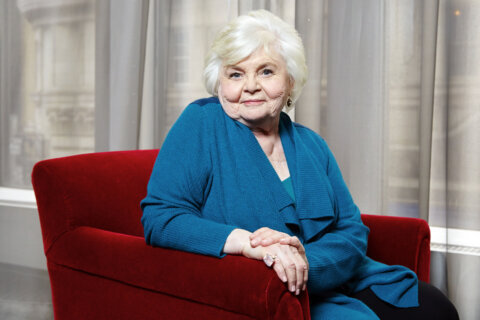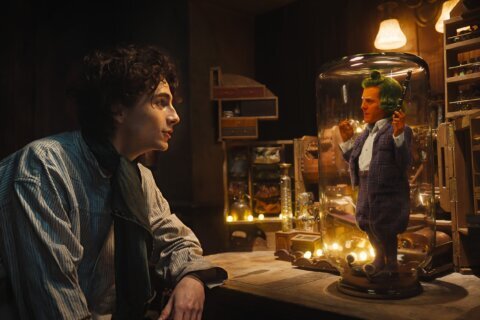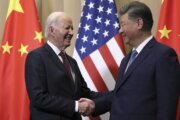Jason Fraley, WTOP Film Critic
WASHINGTON – “Ever since the guy with the hammer fell out of the sky, subtlety kind of went out the window.”
In one line, “Iron Man 3” captures the Marvel Universe with a refreshing self- awareness. On the one hand, the comics offer countless characters with compelling stories. On the other, they’re catnip for tent-pole studio execs, many of whom are more businessmen than movie lovers, having never even seen some of history’s most famous flicks.
Last summer, “The Avengers” (2012) marked the culmination of Marvel’s “Phase One” business plan of “Iron Man” (2008), “The Incredible Hulk” (2008), “Iron Man 2” (2010), “Thor” (2011) and “Captain America: The First Avenger” (2011). It also marked the launch of “Phase Two” in “Iron Man 3” (2013), “Thor: The Dark World” (2013), “Captain America: The Winter Soldier” (2014), “Guardians of the Galaxy” (2014)” and “The Avengers 2” (2015). Don’t worry, Merrill Lynch has already agreed to fund “Phase 3,” at which point the transformation from Hollywood to Wall Street will be complete. I guess “greed is good.”
Needless to say, this strategy was a ripe target for a young critic who, fresh off a master’s dissertation and a month of Oscar coverage, was ready to take a blockbuster to task. The result was a 2 1/2-star rating for what became the smash hit of the summer and the No. 27 grossing movie of all time (adjusted for inflation). Was I so out of touch, or had the business changed that much?
Staring through the egg on my face, I remembered Black Sabbath’s “Iron Man” lyrics: “Has he lost his mind? Can he see or is he blind?” Perhaps my ratings system needed to be properly calibrated, like one of Iron Man’s suits.
And so, a year later, this addicted cinephile found “Iron Man 3” blissfully therapeutic, as Tony Stark suffers from the same “Avengers” PTSD I’ve felt the past year, a temporary paralysis each time I see a 2012 Dodge Avenger, a dizzy reminder of the Von Trapp that snared Pauline Kael, the cold sweat of a critic’s guilt complex for giving a popular favorite a resounding “meh.”
As I walked out of the theater, I wanted to confirm that my enjoyment of the flick wasn’t the result of overcompensation or extra-buttery popcorn. So after rewatching “Iron Man” (2008) and “The Avengers” (2012), I can honestly say that “Iron Man 3” is my favorite Marvel flick yet.
The story picks up after the finale of “The Avengers,” as billionaire tech-wizard Tony Stark (Robert Downey Jr.) works on his Iron Man suits over sleepless nights, suffering anxiety attacks every time someone mentions New York (today’s escapist audiences may suffer similar post-9/11 anxiety).
Stark’s insomnia causes a rift with soul-mate Pepper Potts (Gwyneth Paltrow), who is wooed by biotech genius Aldrich Killian (Guy Pearce). Killian has developed an explosive genetic regeneration process called Extremis, allowing the human body to heal itself, but it’s not yet ready for primetime and is abused by a Bin Laden-style terrorist known as The Mandarin (Ben Kingsley).
The fresh faces of Kingsley and Pearce make “Iron Man 3” feel brand new. Pearce is formidable as the scorned nerd, who harnesses “Memento” as he creates a holographic brain map to discuss the need for a human upgrade. Still, it’s Kingsley who steals the show as The Mandarin, a much more memorable foe than Jeff Bridges in “Iron Man” or Mickey Rourke in “Iron Man 2.” All three are Oscar-nominated or Oscar-winning actors, more than Tom Hiddleston can say as Loki in “The Avengers.”
Grounding the new cast members are such familiar faces as Jon Favreau (director of the first two movies) as Tony’s tech-challenged bodyguard, and Don Cheadle as Rhodey Rhodes (a role begun by his “Crash” co-star Terrence Howard), who has since taken a sidekick role as The Iron Patriot.
The most important supporting character is, of course, Paltrow as Pepper Potts, fresh off her distinction as People magazine’s Most Beautiful Woman in the World. While I’m surprised she got that title 15 years after her prime period of “Se7en” (1995) and “Shakespeare in Love” (1998), Paltrow is way more than just a pretty face here, donning Iron Man suits in trailer-made action.
Still, all this would fall to iron pieces without Downey Jr. While Heath Ledger’s Joker remains the best super-villain of the 21st century, Downey Jr. will go down as this era’s best superhero. His Tony Stark is smarter than Hugh Jackman’s Wolverine, tougher than Tobey Maguire’s Spider-Man and funnier than Christian Bale’s deep-throated Batman. It’s a shame that living comedy/action stars rarely get noticed come awards time, because Downey has really created something special with Stark.
If this is his last time in the role, let’s take a moment to celebrate a great role for a great actor who’s tackled his demons in a way Ledger tragically couldn’t. We love nothing if not a good comeback story, and Downey has now been clean for 10 years. Metal suit or no metal suit, he is an iron man.
For this reason, Shane Black is a fitting choice as writer/director, as it was he who gave Downey another chance in “Kiss Kiss Bang Bang” (2005), a full three years before his official comeback with “Iron Man” and “Tropic Thunder.” This time, Black co-writes with Drew Pearce, who’s slated to write Downey’s “Sherlock Holmes 3,” a buddy flick much like Black’s “Lethal Weapon” (1987-1998).
The buddy dynamic is on full display as Stark rags on Rhodey’s new red-white-and-blue alias and mocks his idolizing fans, from an adult fanboy to an impressionable young kid who’s lost his father (“Dads leave. No need to be such a pussy about it”). The latter provides some of the funniest exchanges I’ve seen in a while, as Downey Jr. puts the “comic” in comic, delivering what James Franco couldn’t in “Oz: The Great and Powerful” (2013), remaining lovable despite being a total smart-ass. The comic tone is there from the start, as Downey stumbles over his words in opening narration.
While Black keeps us laughing, he also keeps us guessing, from major plot twists to minor fake-outs via cool new gadgets. The pieces of Tony’s iron suit not only fly onto his body automatically, they can be operated via remote-control, flipping our expectations as to whether he’s actually in harm’s way.
The script also allows Stark to do some legit detective work, interviewing a suspect’s mother in a honky-tonk and visiting the site of a deadly street explosion, where incinerated victims cast horrific human shadows on a wall, chillingly reminiscent of the Boston Marathon bombing.
In this light, “Iron Man 3” features a surprising level of social commentary, unveiling the theatricality of media-savvy terrorists who use fancy videos as marketing tools. In one video, The Mandarin addresses his audience as “ladies, children, sheep.” In another, he describes Chinese fortune cookies as an American invention: hollow, filled with lies and leaving a bad taste in the mouth. The symbolism of this statement will make sense after you’ve seen the movie.
When it comes to the film’s biggest action sequence, dare I say that “Iron Man 3” beats “Olympus Has Fallen” at its own game with a “make or break” Air Force One attack. The sequence plays out triumphantly, thanks to Black’s use of actual parachute stunt teams, rather than the CGI helicopter raid on Stark’s mansion or the flashy finale that’s a little kiss kiss and a lot bang bang.
Thankfully, there’s more magic realism in “Iron Man” than straight fantasy. While Joss Whedon’s extra-terrestrial wormhole is better matched for the mythic Thor, real-world villains are better suited for Iron Man, who made his money on defense contracting and draws his “super powers” from technology.
Black gets this right in a scene where Stark signs a letter “The Mechanic.” He gets it wrong in another scene by introducing a “fire-breathing” villain. Like your mom said, before you go out the door to a party, take off the last thing you put on. Sometimes less is more.
Overall though, Black gets back to what made the franchise great to begin with: Real characters dealing with real-world problems that they often created themselves by forsaking personal relationships in pursuit of celebrity fame and superhero mid-life crises. The film ignores “Crystal Skull” temptations to become a powerful “Last Crusade” and a far better “threequel” than “Superman III” (1983), “Batman Forever” (1995), “X-Men: The Last Stand” (2006) and “Spider-Man 3” (2007).
Of course, “Iron Man 3” isn’t exactly the third — it’s the fourth if you count “The Avengers” — but the film goes out of its way to avoid talking about that movie, no matter how much the fans beg.
Take note, Marvel: This is the direction you need to go. Treat each movie as its own “stark” journey with its own distinct character arc, not a collection of all-stars teasing to the next phase of a studio business plan. As Stark says at the end, initiate the “clean slate” procedure.
As the final fireworks exploded, I felt a warm calm wash over me as Black nobly wrapped up Downey’s journey in narration that served as metaphor for the series: “You start with something pure (“Iron Man”), then come the mistakes (“Iron Man 2”) and the compromises (“The Avengers”), but this is the best I’ve had in years” (“Iron Man 3”).
Check your mind at the door. Go have fun. It could be the last time to enjoy Downey quite like this.
★ ★ ★ 1/2
The above rating is based on a 4-star scale. Follow WTOP Film Critic Jason Fraley on Twitter @AboveTheJFray or on his blog The Film Spectrum.








